Gretchen Hirsch's Blog, page 7
November 16, 2015
Announcing the Knit Wrap Top Sew-Along
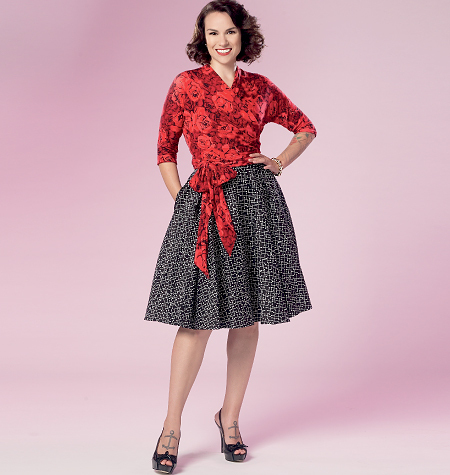 I'm super excited to announce that I'll be doing a sew-along here for the B6285 knit wrap top! I think this project is perfect for a sew-along because it's so wearable, no matter what your personal style. It goes well with high-waisted skirts and pants but also works as to layer over dresses or longer tops.
I'm super excited to announce that I'll be doing a sew-along here for the B6285 knit wrap top! I think this project is perfect for a sew-along because it's so wearable, no matter what your personal style. It goes well with high-waisted skirts and pants but also works as to layer over dresses or longer tops.
It's also a fairly quick project because there are only two pattern pieces! The top front and back are cut in one--no sleeve seams or shoulder seams even! And the finishing is minimal because the whole thing is self-lined. This avoids pesky knit hems.
 If you think you'll participate, grab the pattern now! I'll post later this week about fabrics and other supplies. We'll start sewing the week of 11/23 and take it at a fairly leisurely pace.
If you think you'll participate, grab the pattern now! I'll post later this week about fabrics and other supplies. We'll start sewing the week of 11/23 and take it at a fairly leisurely pace. In the meantime, let me know if you have questions! I do hope you'll participate!
In the meantime, let me know if you have questions! I do hope you'll participate!
Published on November 16, 2015 04:00
November 12, 2015
Purple Pom Pom Explosion Skirt
 So I have this skirt from Modcloth, and it's the best basic retro skirt ever. Whenever I post pictures
So I have this skirt from Modcloth, and it's the best basic retro skirt ever. Whenever I post picturesof me in it (which is often, because it foes with freaking everything), I get tons of questions about it. Naturally, this being a sewing blog, people assume I made it. How embarrassing to admit that I didn't! (Any seamstress will relate to this feeling, I'm sure.) Because, while I didn't make it, I surely could have! It's just two circle skirts sewn together at the waistband. It doesn't even have a lining!
 Paired with Pink Floral Casual Blouse
Paired with Pink Floral Casual Blouse
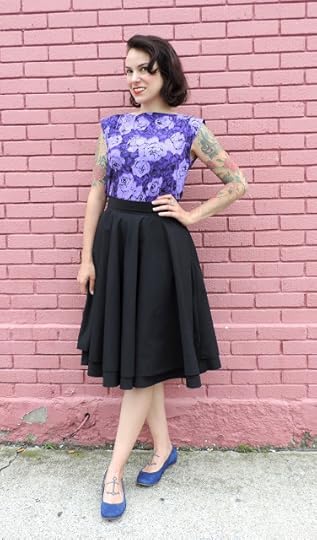 Paired with Purple Floral Knit TopTo regain my pride, I decided to make my own version of the skirt. Is it a nice, neutral basic like the original? I'm afraid not. It's done in a purple atomic print with yards and yards of pom pom trim and a purple lace-trimmed lining. I always felt like the original design was a missed opportunity to call out the double hem with a trim, and I'm currently obsessed with pom poms, so it was a natural pairing.
Paired with Purple Floral Knit TopTo regain my pride, I decided to make my own version of the skirt. Is it a nice, neutral basic like the original? I'm afraid not. It's done in a purple atomic print with yards and yards of pom pom trim and a purple lace-trimmed lining. I always felt like the original design was a missed opportunity to call out the double hem with a trim, and I'm currently obsessed with pom poms, so it was a natural pairing.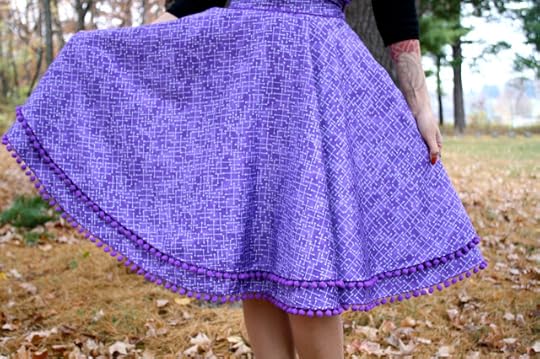
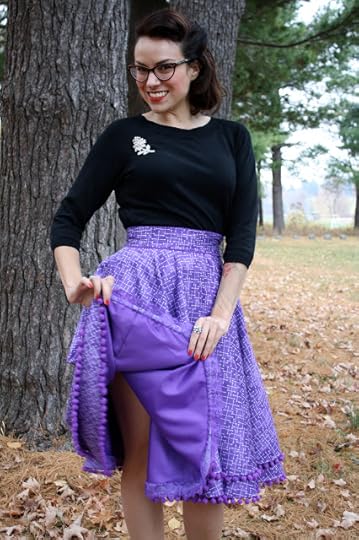 Here's how I did it. I made two circle skirt patterns for my waist size (I always get out my copy of my first book to remember how to do this, but there are instructions all over the internet too). One skirt pattern is 24.5" long and the other is 22.5" long. I cut the longer skirt pattern out in the atomic print, and then cut the shorter skirt pattern out in the atomic print and the lining. You'll need a front and a back for each layer of skirt. As you can imagine, this takes a lot of fabric. But the feeling of fullness with the three layers is fantastic.
Here's how I did it. I made two circle skirt patterns for my waist size (I always get out my copy of my first book to remember how to do this, but there are instructions all over the internet too). One skirt pattern is 24.5" long and the other is 22.5" long. I cut the longer skirt pattern out in the atomic print, and then cut the shorter skirt pattern out in the atomic print and the lining. You'll need a front and a back for each layer of skirt. As you can imagine, this takes a lot of fabric. But the feeling of fullness with the three layers is fantastic.Sew all the side seams, leaving an opening on one side of each layer for a zipper. I inserted an invisible side sip into the short atomic layer only. We'll call this the "outer layer" now. Then place the lining into the long atomic skirt, wrong sides together and baste around the top and the zipper opening. Clip into the seam allowances at the base of the zipper opening (this allows you to turn them in and slipstitch to the zipper tape.) We'll treat this unit as the "lining layer" from here on out.
Drop the lining layer into the outer layer and baste them together around the waistline. Turn in the zipper opening seam allowances on the lining lining and slip stitch them to the zipper tape.
Next, I made a waistband! It's two inches high and has a one inch underlap for the button fastening. I inserted petite pom pom trim into the top and bottom of the waistband (tutorial here).
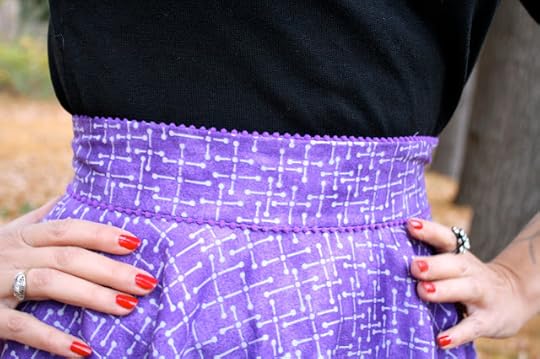
Next, I let the skirt hang for almost 48 hours on my dress form to let the bias settle. Finally, I evened up the hemlines on all three layers (the bias stretched quite a bit on the cotton sateen, but not on the lining). I made sure that the bottom layer was still exactly two inches longer than the top layer. I serged the bottom of each outer layer, then basted large pom pom trim to the very edge, with the pom poms facing upwards. Warning: get 10.5 yards of pom pom trim for this! I had 10 and just barely eked it out. Flip the pom poms trim to the inside of the skirt and then top stitch in place.
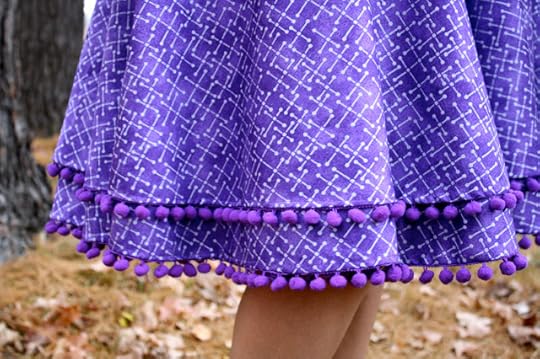
I serged purple lace to the lining hem. I love how all the layers look together!
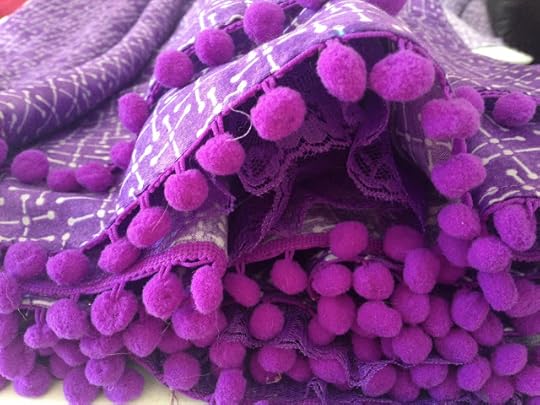

Do a button and buttonhole on the waistband, and that's it! An explosion of purple and pom poms that's surprisingly wearable.

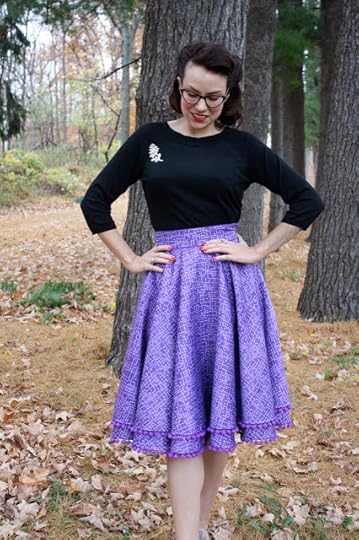
Hey, I also got new glasses! I couldn't find a decent cateye anywhere so I ordered these frames from Victory Optical and had my prescription put in. I love them so much.

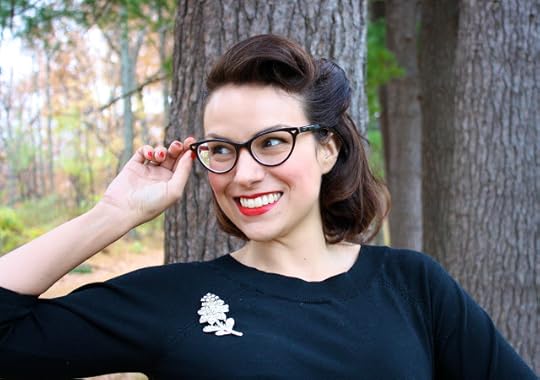
I'm dying to make a version of this skirt in plain black with pom poms. Adding it to the project queue! (I found an Etsy shop that sells pom pom trim in bulk for a really great price. You have to wait for it to come from Asia, but it may well be worth it. I'll let you know!)
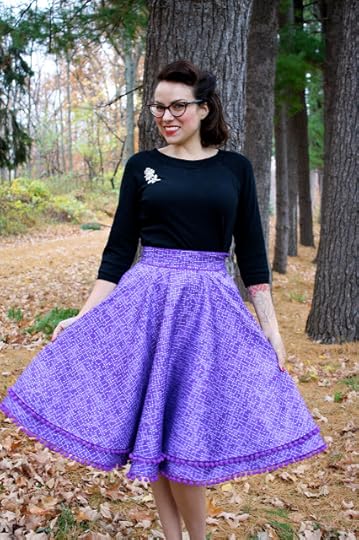
Published on November 12, 2015 04:00
November 11, 2015
Susanne Bisovsky's Vienna Studio
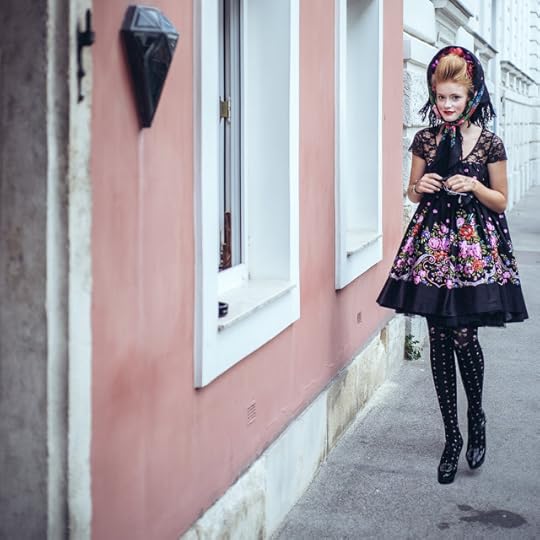 One of Susanne Bisovsky's designsOne of the absolute highlights of my trip to Vienna and Munich was getting to visit designer Susanne Bisovsky's studio. You know when you meet someone and you think, "When I grow up, I want to be just like her!"? That was my experience of meeting Susanne.
One of Susanne Bisovsky's designsOne of the absolute highlights of my trip to Vienna and Munich was getting to visit designer Susanne Bisovsky's studio. You know when you meet someone and you think, "When I grow up, I want to be just like her!"? That was my experience of meeting Susanne. 
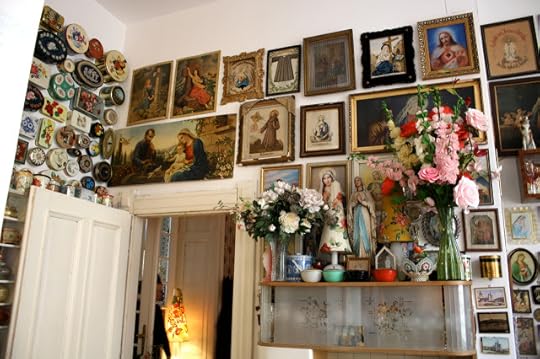
You need to make an appointment to visit the studio, and it is absolutely worth it. Not only did I get to see all of Susanne's beautiful designs, but also the space she inhabits to both work and live. This is noteworthy because, of anyone I've met, she has an aesthetic that permeates everything she does. Every corner of her space is beautiful and filled with lovely things. This is a little nook in her kitchen, for instance!
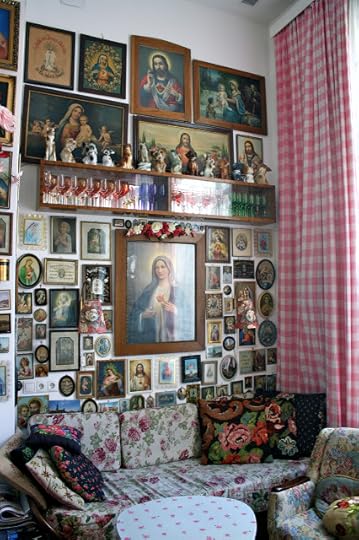
I was initially interested in Susanne's work because she designs dirndls, but they're really a small part of what she does. Her ready-to-wear line is much larger, and is just stunning. Susanne designs all the fabrics and has them printed exclusively. Every piece I looked at was more beautiful than the last.
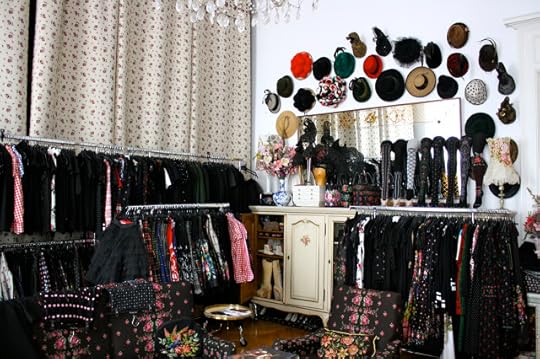
I also learned that she designs dirndls for Sportalm, which might explain why I like them so much.
Her studio is filled has sky-high ceilings, gorgeous fabrics, and crinolines hanging from the ceilings.

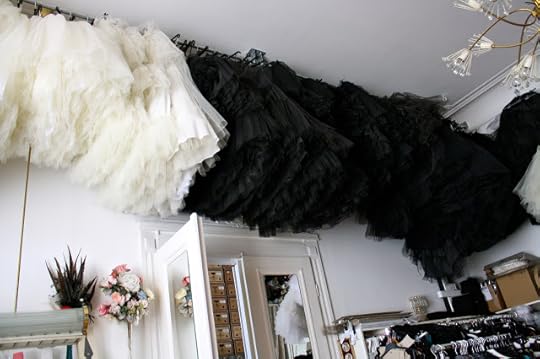
I was delighted when Susanne dressed me up like a doll. Look at that beautiful handmade Frida-Kahlo-inspired headpiece!
 She showed me some tricks for wearing headscarves and hats. I was totally in heaven.
She showed me some tricks for wearing headscarves and hats. I was totally in heaven.
I bought the skirt as a souvenir and Susanne packed my bag with little gifts like a pair of these beautiful socks.

I think I've met someone who loves roses as much as I do!


How could I not love someone who collects vintage yarn poodles at flea markets?

Here are a few more photos of Susanne's designs. As you can see, she's inspired by vintage florals, traditional embroidery, and layered textures and prints.
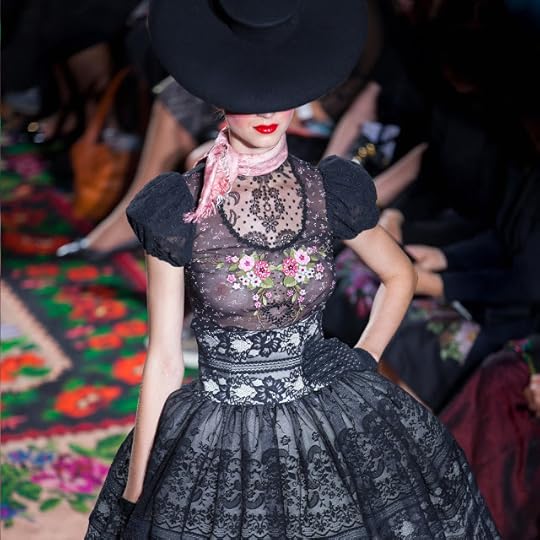
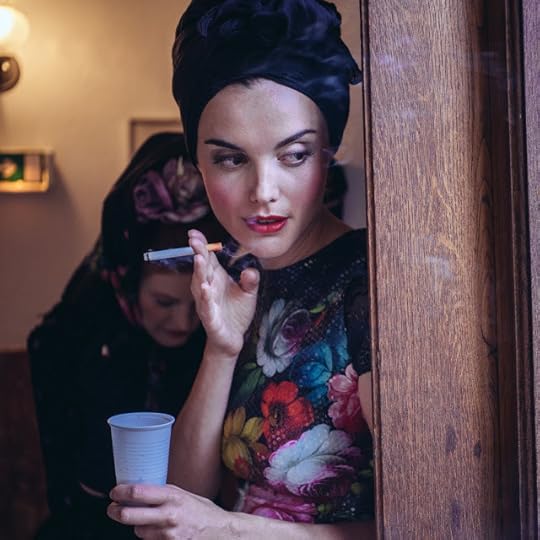
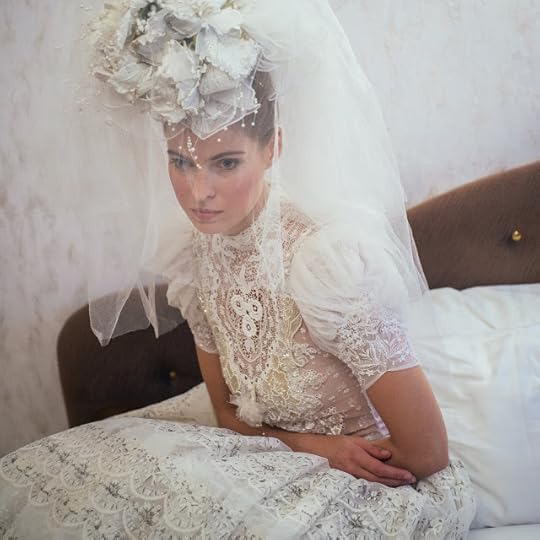
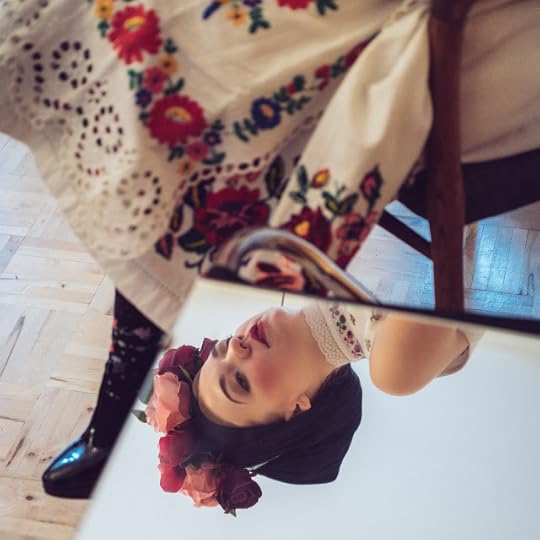
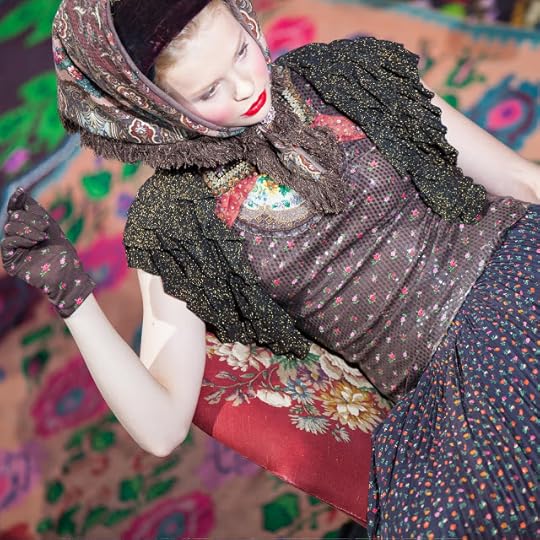 A big thank you to Susanne for such a hospitable welcome and dreamy visit!
A big thank you to Susanne for such a hospitable welcome and dreamy visit!
Published on November 11, 2015 04:00
November 10, 2015
Tutorial: Using Pom Pom Trim in a Seam
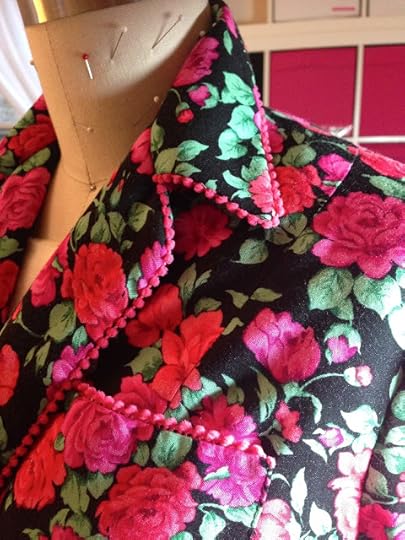 When you imagine pom pom trim, you probably think of the big dangly kind that you might see on curtains. But pom pom trim comes in several sizes, from mini to jumbo! And there's a particular kind, often labeled as "petite" that is ideal for garment sewing projects because you can insert it right into a seam. This method is very similar to using piping, where the trim gets sandwiched between two seam layers. It can go into collars, cuffs, shirt front openings, necklines, and anywhere you have two layers of fabric stitched together in a seam (usually one layer is the garment outer, and the other layer is a facing, which means that one may be interfaced).
When you imagine pom pom trim, you probably think of the big dangly kind that you might see on curtains. But pom pom trim comes in several sizes, from mini to jumbo! And there's a particular kind, often labeled as "petite" that is ideal for garment sewing projects because you can insert it right into a seam. This method is very similar to using piping, where the trim gets sandwiched between two seam layers. It can go into collars, cuffs, shirt front openings, necklines, and anywhere you have two layers of fabric stitched together in a seam (usually one layer is the garment outer, and the other layer is a facing, which means that one may be interfaced).Shopping note: I've purchased most of my petite pom pom trim from this online shop, and have been very happy with them. I've also found it on Etsy, so look around!
Like piping, this kind of insertion works visually to emphasize seamlines. It can also add a splash of a contrasting color. And pom pom trim has a certain whimsy to it that makes any garment fun!
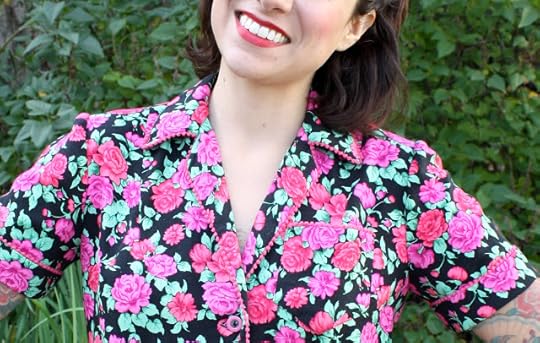
Here is what petite pom pom trim looks like before you sew it:

Much like piping, the pom pom trim has a "flange" or "lip" that allows you to sew it easily to a seam allowance. I would avoid the mini or baby pom pom trim that doesn't have this lip, because it's much harder to sew on the edge. Here's an example:

Here is the method I use to insert the trim into a seam. First, on one of the pieces, stitch a line of staystitching right along the seamline. So, if your seam allowance is 5/8", this line of stitching will be exactly at 5/8" from the edge of the fabric.
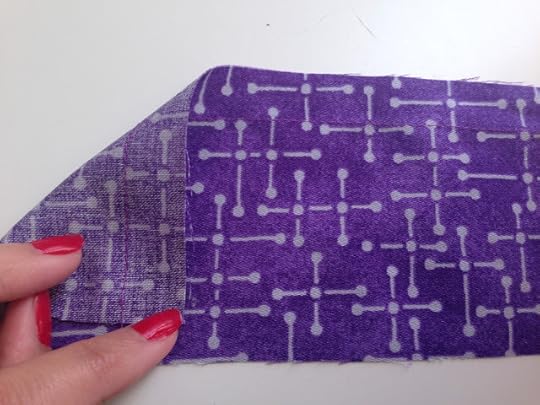
Next, use this line of stitching to help you place your pom pom trim. The little balls of the trim should go just to the garment side of the staystitching. Using a zipper foot, baste the pom pom trim in place. It doesn't matter where you stitch, right in the center of the "flange" is fine. I place the pom pom trim as I'm stitching (rather than pinning first), because it's easy to see underneath the trim to the staystitching.
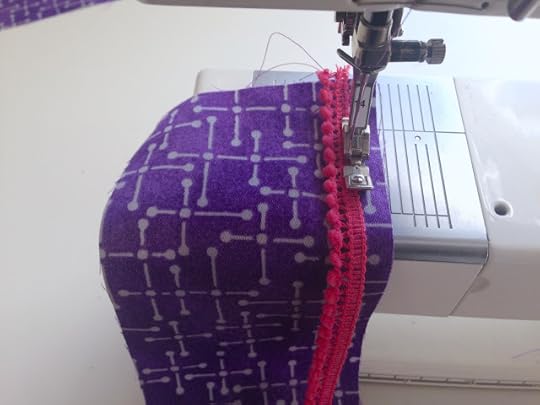
Now, grab the other layer of your garment and place the two layers right side together, as you normally would to sew.

With your zipper foot still on, and stitching with the staystitching on top, place another line of stitching right on top of the staystitching. (See? The stay stitching works as a guide both for placing the trim and for making sure your stitching is accurate in this step!)
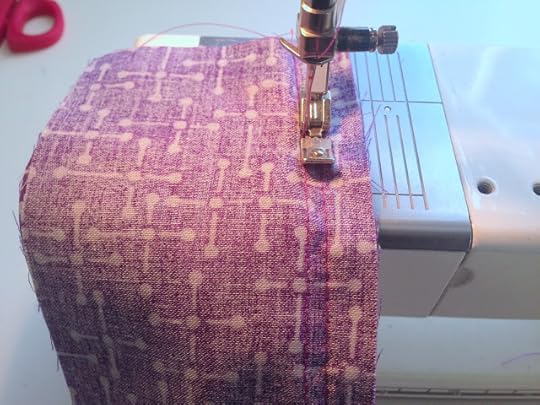
Trim and grade the seam allowances. Understitch the seam allowances to the facing using the zipper foot, if necessary/desired.

Press the layers so the wrong sides are together. Your little pom poms are just peeking out of the seam!

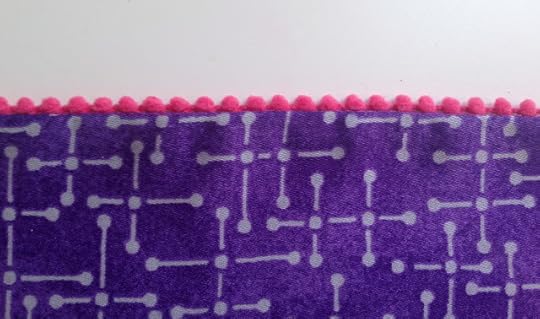
That's all there is too it. Just be careful: using pom pom trim is totally addictive!
Published on November 10, 2015 04:00
November 9, 2015
Inspiration: That Touch of Mink

I had a mostly lazy weekend, and Doris Day films featured prominently in my activities. Have you seen That Touch of Mink? It's such a fashion treat! The clothes are done by the great Norman Norell, and there's a fantastic personal shopping scene. This is one of my favorite conceits of movies of this time: the personal fashion show! (There's a great one in How to Marry a Millionaire, which I also happened to watch this weekend. No wonder I didn't get any sewing done.)
The best thing about this particular scene is the coat at the end. It has a fur lining and interchangeable shells in satin and wool. How fascinating is that? (I also love the pink satin and lace pant ensemble toward the middle.)
It seems like the two layers connect somehow at the center front but otherwise the fur lining just sits inside the outer shell. It would be fun to do something similar with the wonderful faux furs they're making these days.
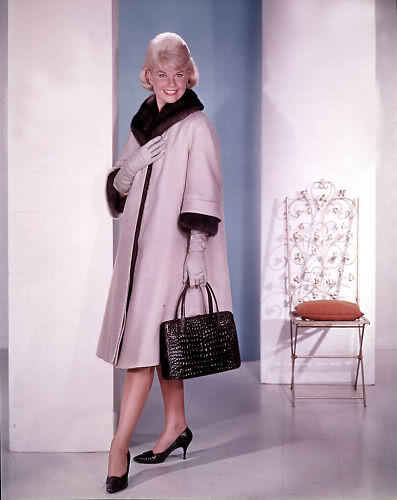
I highly recommend the movie for that scene alone, but also the stunning strappy dress that feels both modern and perfectly vintage.
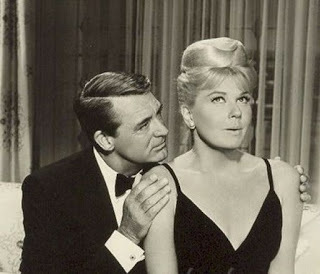
It's also well worth a watch for the scenes with Doris Day and her best friend (played by Audrey Meadows) communicating through the windows of the automat.
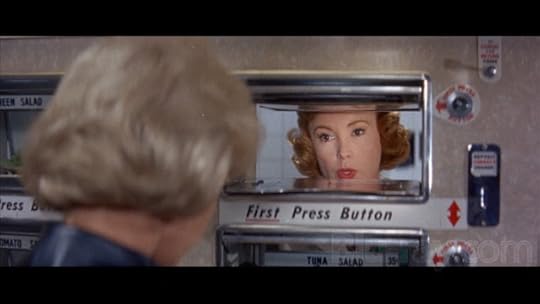
Apparently automat workers had the cutest uniforms ever. Who knew?
I hope you got more sewing done than I did this weekend!
Published on November 09, 2015 04:00
November 6, 2015
An Interview with Erika Neumayer of Rare Dirndl
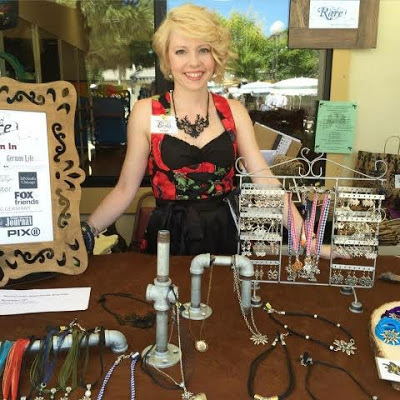
Special post today, readers! As you know, I can back from Europe with a bit of a dirndl bug. I wrote about the obsession, the boning, the trim, the wearability, and more. (As a side note, I'm still planning my own dirndl project, but I'm a but intimidated to get started!) Through my posts, I became acquainted with the work of Erika Neumayer, who owns the company Rare Dirndl. The unique thing about this company is that it's based right here in the USA, and all the dirndls are made in Chicago. I was so intrigued by all this that I had to ask Erika some questions! All photos are courtesy of Erika and you can learn more about the pieces at Rare Dirndl.
Tell us a little about what you do and how you got into it.
I am the owner and designer of Rare Dirndl, which is a line of traditional German style clothing and accessories that are fresh, modern and edgy. On a weekly basis I do everything from sewing the first samples to advertising, social media, shipping online orders and finding/sourcing new products and fabrics that my customer would love!
I grew up in the German community in Chicago, dancing with the American Aid Society of German Descendants since the age of 4 and when I graduated from Dominican University with my degree in Apparel Design, I was underwhelmed with the dirndl selection available in the US. At the time I was seeing German designers creating new and modern designs and the american market was stale to say the least. So in 2010, I decided to do something about it! I started Rare Dirndl (in my parents dining room and living room... now I have my own space).

How did you learn to make dirndls? Do you consider your construction techniques to be very traditional?
I pretty much taught myself. In 2007, the dance group traveled to Europe and while I was there I picked up a couple pattern books and bought myself a high end dirndl. With those two things as a base, I started to make pattern edits and tried to mimic the construction of my Krüger dirndl. Rare Dirndls come in the traditional midi length (approximately 26" from the waist to the hem) as well as a mini (20"). The side seams are also exposed which is very common in dirndl construction to make them easy to alter for that perfect fit. Another thing that is "traditional dirndl" about the construction is the use of piping, which I also utilize.
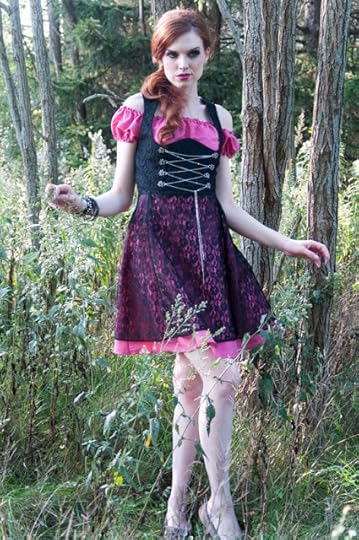
Your line is produced in Chicago. Do you work with a factory? How did you learn how to navigate the world of fashion production? Was it difficult to find a place that could make the pieces you designed?
I work with a pattern-maker, digitizer & grader, cutter, small manufacturer, and seamstress... all different people. It is tricky to keep track of everything, but this process allows me to make the garments in small quantities, (4-10 pieces per style) and add the subtle and important details to the dirndls. There are a few places in the city that can help with the production process, but I learned about all my sources through word of mouth. It took about 3 years to get everything coordinated and working smoothly.
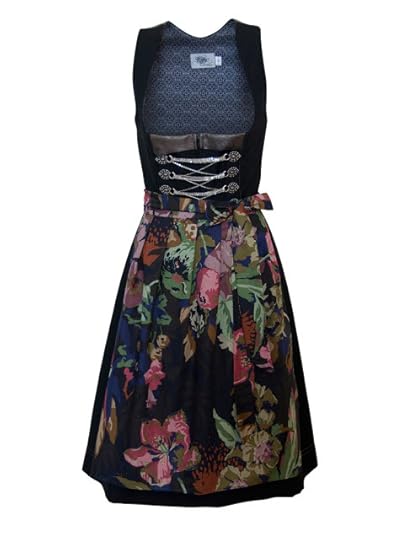 We had a big discussion here about dirndls and wearability. Do you have customers who wear dirndls on an everyday basis or is it for Octoberfest/special occasions? How often do you wear a dirndl?
We had a big discussion here about dirndls and wearability. Do you have customers who wear dirndls on an everyday basis or is it for Octoberfest/special occasions? How often do you wear a dirndl? Most of my customers have more than 1 dirndl and have a lot of places to wear their dirndls, but they are usually for special occasions. For example a picnic for their german club or wedding would be a place they'd wear their dirndl too in addition to Oktoberfests. Or if they're going to a German restaurant they might wear their dirndl, but I don't know anyone that wears a dirndl on an everyday basis. I would say that I wear a dirndl once a week May-September and then sporadically throughout the rest of the year... so much more than your average person!What do you think the most important construction features are on a dirndl?
I think the most important thing is bodice structure/fit and the detailing is also very important. But that could be anything from a ribbon lace up front to hand pleated trimming, to spikes and fur (in my case ;-). The attention to detail is what makes a dirndl so extraordinary!

What do you use provide structure to the bodice? Interfacing? Boning? Please share!
Most dirndls have a layer of woven fusible interfacing to give the bodice more strength (the suede and heavier fabrics don't need it). All bridal dirndls have a layer fusible interfacing. I also use Rigiline boning sewn into the center front seam, over the zipper. This has proven to be a very important detail that helps tremendously with fit. These are some of the reasons well made dirndls are so expensive (the bargain one on amazon won't have these kind of details).
Any upcoming projects or lines you'd like to tell us about?
I'm launching my first holiday collection this year and I'm very excited about it. It's a very high-end mini collection inspired by legend of Krampus. I utilize very unusual textiles like alligator skin vinyl, fur with spikes, suede, and woven ribbon lace. We just had the photo shoot a few weeks ago and the pieces are in production right now! I'm also working on new accessories for the holiday season like a hoodie, scarf, hat, gloves etc. These are more for everyday. My customers love the idea of showing off their heritage all year long even when they can't wear their dirndl.
 Forthcoming Krampus collection lookA big thank you to Erika of Rare Dirndl for agreeing to this interview! I hope you've enjoyed this little glimpse into a small American dirndl company.
Forthcoming Krampus collection lookA big thank you to Erika of Rare Dirndl for agreeing to this interview! I hope you've enjoyed this little glimpse into a small American dirndl company.
Published on November 06, 2015 04:00
November 4, 2015
New Winter Patterns
 Yay, I always get excited when new patterns are out! Butterick has just released the Winter/Holiday collection, and I have two new looks in the Patterns by Gertie line. Once again, I got to serve as both designer and model, which I love to do. Since I've always designed and sewn for myself, it just comes a little more naturally than working with another model.
Yay, I always get excited when new patterns are out! Butterick has just released the Winter/Holiday collection, and I have two new looks in the Patterns by Gertie line. Once again, I got to serve as both designer and model, which I love to do. Since I've always designed and sewn for myself, it just comes a little more naturally than working with another model.Since I've done lots of strappy and sleeveless dresses in the past, I wanted to focus on designs that were vintage glam, but with an everyday quality to them. The first outfit is B6285, a two-piece set that looks great together but that you can easily mix and match with other garments. The top is knit, while the skirt is woven, a combination I've always liked.
 The top is a knit wrap with tie ends and either short or three-quarter sleeves. It's shown in my floral rayon spandex knit (available in all colors at Joann store, or in grey and purple online). It has kimono sleeves and a v-neck back. It's fully lined in self fabric, giving a clean finish.
The top is a knit wrap with tie ends and either short or three-quarter sleeves. It's shown in my floral rayon spandex knit (available in all colors at Joann store, or in grey and purple online). It has kimono sleeves and a v-neck back. It's fully lined in self fabric, giving a clean finish.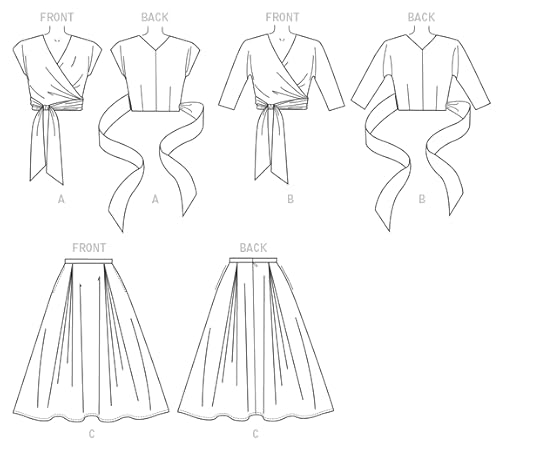
Now about the skirt. The cool feature it has is double box pleats, meaning that there are two pleats right on top of each other. This gives extra fullness and a cool folded effect. It also has pockets, hurrah! It's shown in my jacks print sateen, also available in purple/grey.
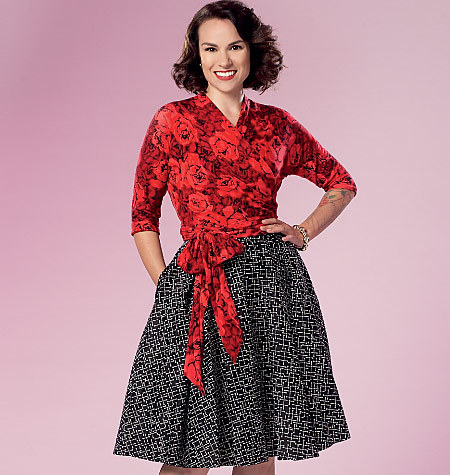
I was pleasantly surprised at how nicely these prints worked together.
Next up, a dress!
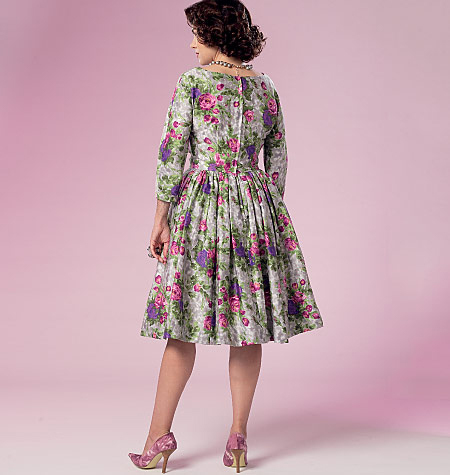
B6284 is a boat-neck, three-quarter kimono sleeve dress with underarm gussets, bodice ruching, and a full gathered skirt. It's a great pattern to showcase a beautiful print, like this new grey floral sateen.

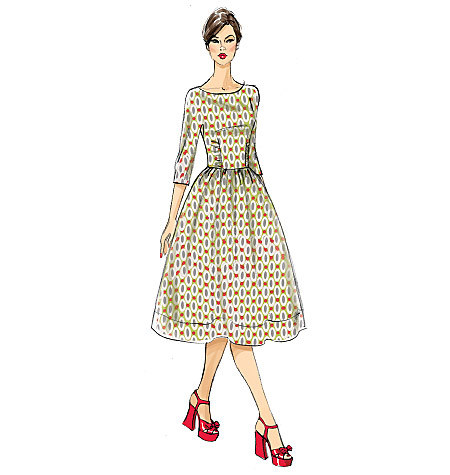
I can see this in lots of different prints for winter, both work and play. Or how about a nice wool solid, with a big statement brooch?
Amazingly, my designs made the cover again. It's such an honor. I hope you like the new patterns!
Published on November 04, 2015 04:00
November 3, 2015
Vintage Casual '40s Blouse in Pink Floral Challis (with Pom Pom Trim!)
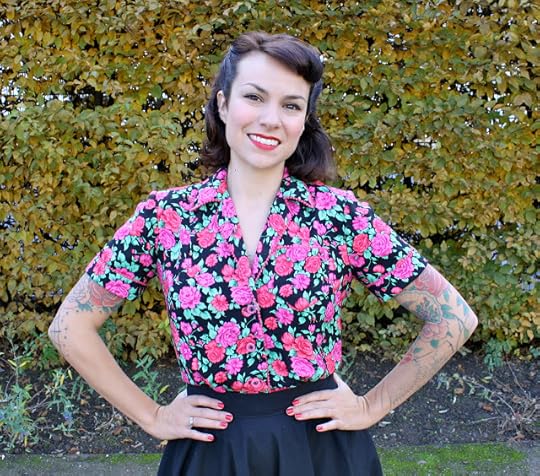
I'm back home from Vienna and Munich and have a ton to write about now! But first I wanted to show off this finished project because I'm so happy with it. This is the "'40s Style Blouse" from my book Gertie Sews Vintage Casual. This project was shown in plaid cotton shirting in the book, and this rayon challis gives it a competely different feel.

Ah, the old pink hair! I do miss it sometimes.
This fabric is from my new fall line, so of course I was super excited to sew with it. I love rayon challis for its softness and beautiful drape.

The blouse has a breast pocket and sleeve cuffs. I highlighted the design details with little pom pom trim all around! I'm going to do a separate post on how to work with this type of trim, because there's so much to say. The great thing is that it can be inserted into a seam, just like you do with piping.

I could seriously use this trim on almost every project I make.
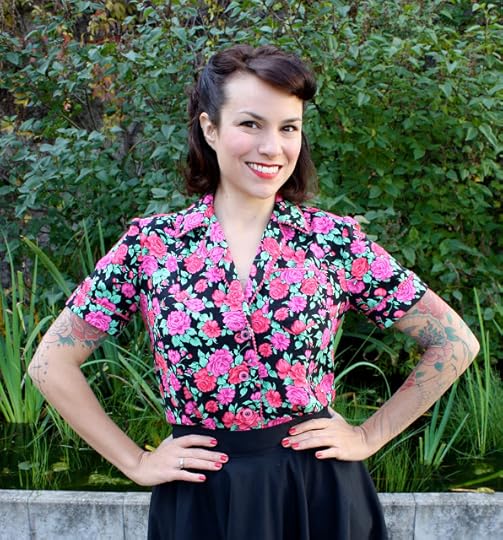
I made the pattern in a size 8, and I like how it has a looseness to it. It drapes nicely when tucked in, thanks to the dart tucks at the waist.

I found some cute little pink and clear plastic buttons at Joann.

I paired the blouse with a basic black skirt from Modcloth.
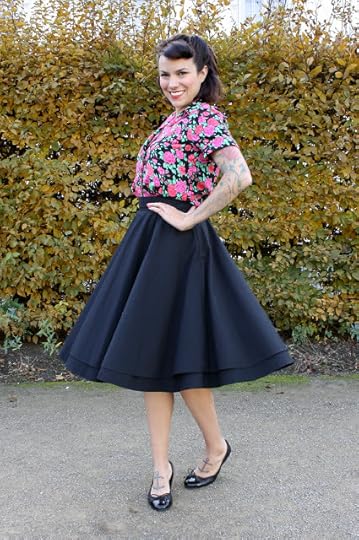 Every time I wear this skirt, I get questions about it. So here goes, in advance: it's two circle skirts (one a few inches longer than the other) sewn together at the wide waistband. It's black cotton, no lining. It would be very easy to reproduce, in fact I've been planning on making my own version for some time.
Every time I wear this skirt, I get questions about it. So here goes, in advance: it's two circle skirts (one a few inches longer than the other) sewn together at the wide waistband. It's black cotton, no lining. It would be very easy to reproduce, in fact I've been planning on making my own version for some time.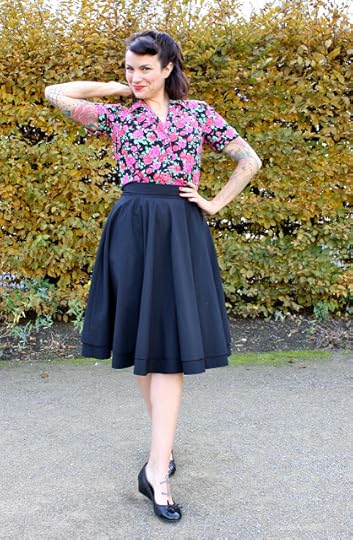
Here you can see the grand backdrop of a building in Vienna. Oh how I love that city!
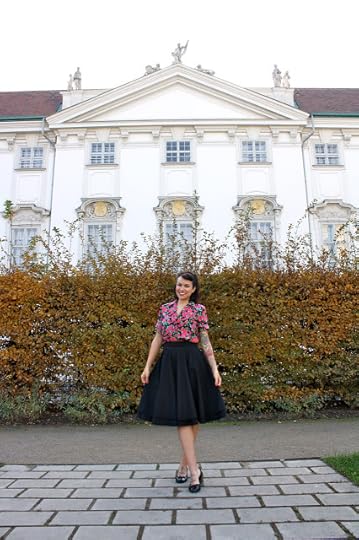 I'm so pleased with this project as an addition to my wardrobe. Look for a pom pom trim post soon!
I'm so pleased with this project as an addition to my wardrobe. Look for a pom pom trim post soon!
Published on November 03, 2015 04:00
October 27, 2015
Hallo from Vienna
 I made it! It's been a fantastic three days in in beautiful Vienna. Thank you all so much for your recommendations on what to see and do here; it's been immensely helpful.
I made it! It's been a fantastic three days in in beautiful Vienna. Thank you all so much for your recommendations on what to see and do here; it's been immensely helpful.As soon as I got to my hotel, I saw a lovely dirndl in the lobby. It really is the land of dirndl!
 This one is by Dirndl Herz, and I really love the unusual fabric and the way the apron is draped on the mannequin.
This one is by Dirndl Herz, and I really love the unusual fabric and the way the apron is draped on the mannequin.After a nap, one of the first things I did was visit Lena Hoschek's boutique. It's quite tucked away in the MuseumsQuartier, on a little side street.
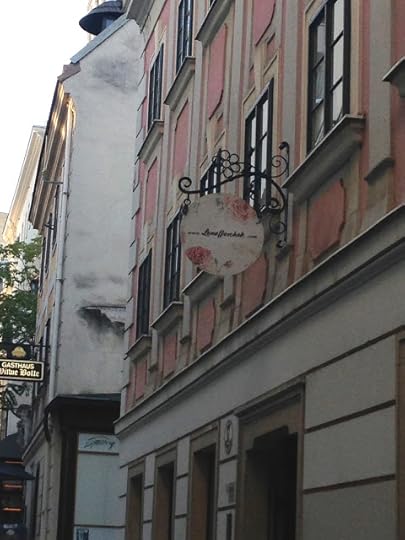
The shop is cozy but packed with beautiful things.
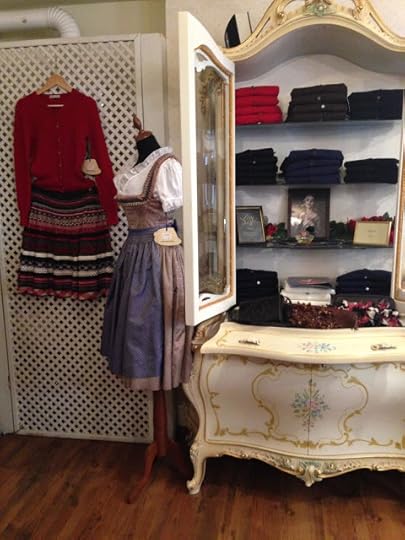
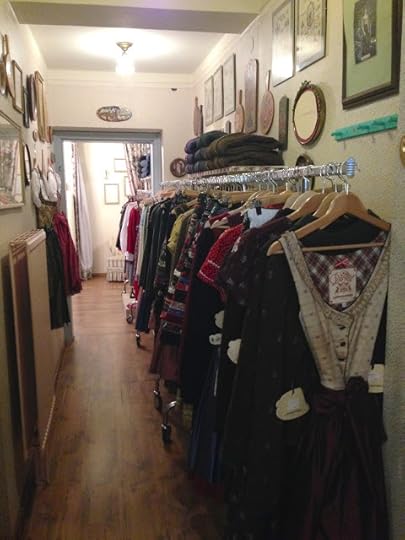
 Here's the adorable salesgirl, who spoke perfect English and even gave recommendations on vintage shops.
Here's the adorable salesgirl, who spoke perfect English and even gave recommendations on vintage shops.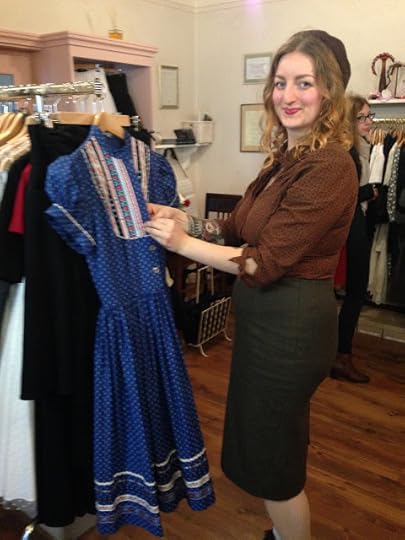 I might have left with that blue dress and a couple other things too.
I might have left with that blue dress and a couple other things too.Next up: cake! Cafe Landtmann came highly recommended from a commenter, and it was every bit as wonderful as anticipated. In fact, I've gone three times in three days.
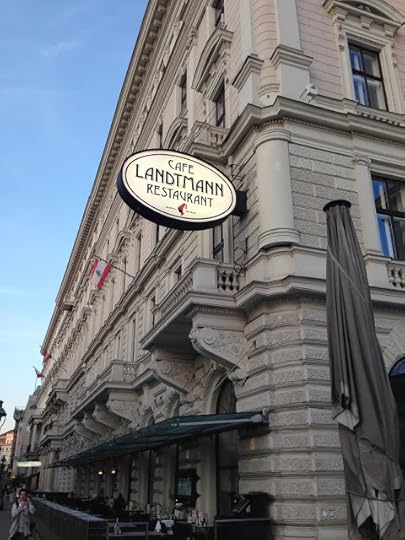
I cannot get enough of this gorgeous cake, the Landtmann Feine Torte.
 And the coffee!
And the coffee!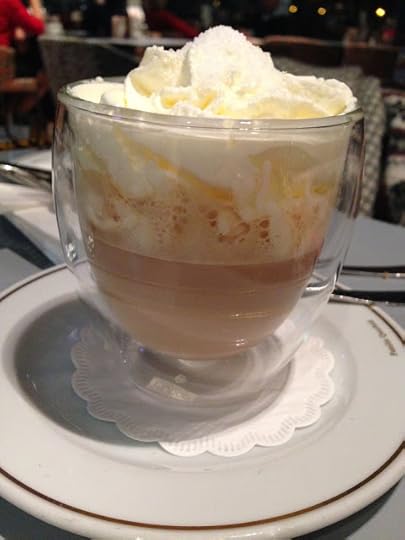 The next two days were a Sunday and a National Holiday, so all shops were closed. This got me to do some cultural things like visit the Sisi Museum.
The next two days were a Sunday and a National Holiday, so all shops were closed. This got me to do some cultural things like visit the Sisi Museum.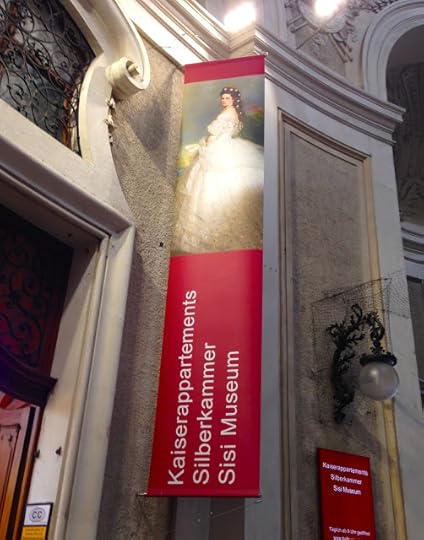
I took some pictures of the wigs that showed her hairstyles and one beautiful dress, before I was rebuffed by a guard (whoops).

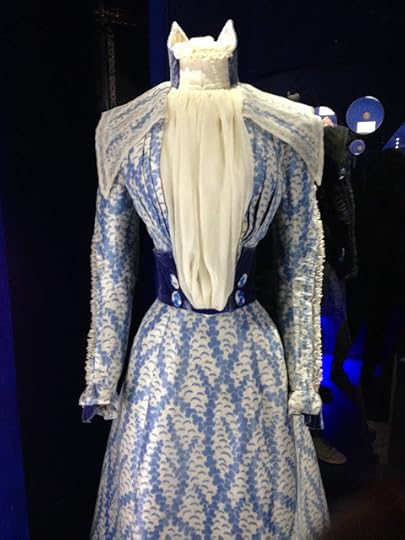
I also went to MAK and saw this gorgeous piece of embroidery.
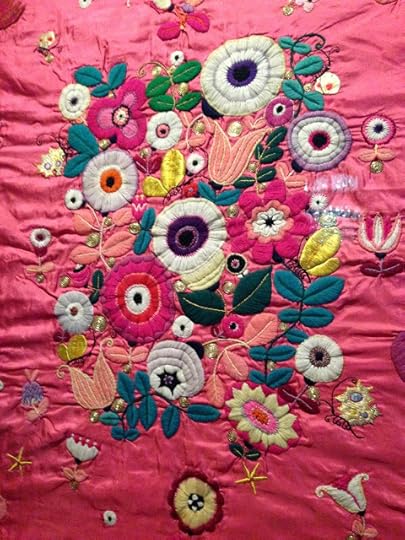 But perhaps my favorite thing I saw was this giant pink bunny near the Opera House.
But perhaps my favorite thing I saw was this giant pink bunny near the Opera House.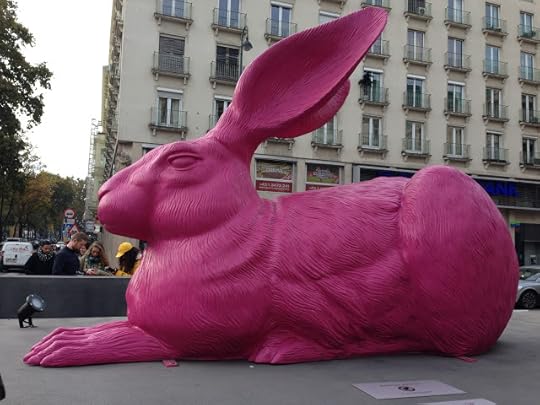 After posting it on Instagram, I learned from a helpful commenter that it's a big 3D representation of Albrecht Dürer's Hare made to promote last year's Dürer exhibit at the Albertina. So much better in pink! (If you ask me.) It was also mentioned on Instagram that it's available in smaller form in the museum gift shop, so . . .
After posting it on Instagram, I learned from a helpful commenter that it's a big 3D representation of Albrecht Dürer's Hare made to promote last year's Dürer exhibit at the Albertina. So much better in pink! (If you ask me.) It was also mentioned on Instagram that it's available in smaller form in the museum gift shop, so . . .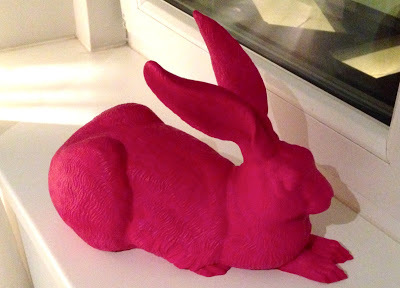 It's perfect for my sewing room shelf! I did go through the museum as well, of course, including the Munch exhibit, which was so perfectly dark and pained. Wonderful!
It's perfect for my sewing room shelf! I did go through the museum as well, of course, including the Munch exhibit, which was so perfectly dark and pained. Wonderful!The city bike system here has been really handy (aside from the fact that the stations can fill up so it's hard to return your bike sometimes). But I highly recommend using a bike to get around Vienna. There are great bike lanes and beautiful sights all around.
 It's even fantastic at nighttime since all the bikes are equipped with lights. I got to see this amazing light show at the Natural History and Art History museum, which projected colorful patterns onto the facades on the buildings.
It's even fantastic at nighttime since all the bikes are equipped with lights. I got to see this amazing light show at the Natural History and Art History museum, which projected colorful patterns onto the facades on the buildings.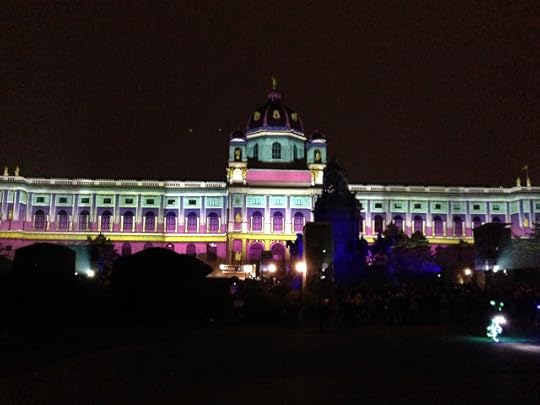
The next day is all about fabric, fashion, and dirndls, so I will have much more to report!
Published on October 27, 2015 04:00
October 21, 2015
Upcoming: Vienna and Munich
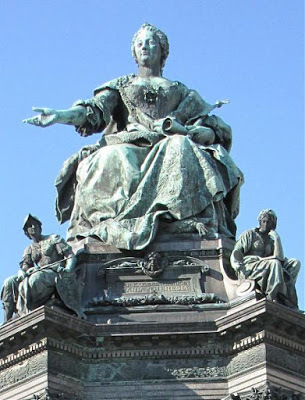
Well, I was so taken by Austria and Germany (particularly the traditional fashion) that I've jumped on an opportunity to make a return trip. Soon. Like in two days. I'll be spending half my time in Vienna and then heading to Munich.
I went to Vienna this summer on my Europe trip with my mom, for about 12 hours. Obviously it struck a chord! I got to do a quick walking tour, visit Schönbrunn Palace, and go to a Mozart concert. It just gave me a taste, and I'm going back to see things that are more personal to my interests. And this will be my first time in Munich.
One of my primary purposes is to do fashion and fabric research, and I want to see all the dirndls I possibly can. Obviously I will be visiting the boutiques of some of my favorite designers like Lena Hoschek, Julia Trentini, and Noh Nee. I'll visit some traditional houses like Gössl, and stare inside the dirndls to better understand the boning and construction.
 Lena Hosheck store in ViennaI'm also excited to see a couple museums like the Sisi Museum, to see some gowns that belonged to Empress Elisabeth, and the Fashion Collection at the Wien Museum.
Lena Hosheck store in ViennaI'm also excited to see a couple museums like the Sisi Museum, to see some gowns that belonged to Empress Elisabeth, and the Fashion Collection at the Wien Museum.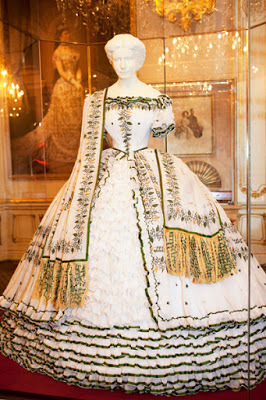 Gown at the Sisi MuseumAnd of course I'm looking forward to some of that amazing Viennese espresso and cake. I had to take a picture of mine when I was there with my mom!
Gown at the Sisi MuseumAnd of course I'm looking forward to some of that amazing Viennese espresso and cake. I had to take a picture of mine when I was there with my mom!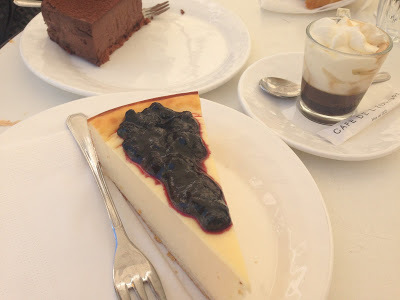
I'd really love some recommendations beyond all this, readers. Fabric stores, vintage shops, interesting designer boutiques, shoe stores, restaurants, museums, sights, etc! Please share your favorite inspiring places in Vienna and Munich.
Published on October 21, 2015 04:00
Gretchen Hirsch's Blog
- Gretchen Hirsch's profile
- 49 followers
Gretchen Hirsch isn't a Goodreads Author
(yet),
but they
do have a blog,
so here are some recent posts imported from
their feed.



